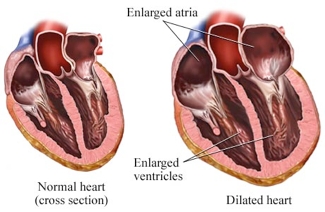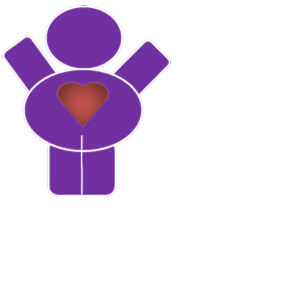Dilated Cardiomyopathy
In dilated cardiomyopathy the myocardium (heart muscle) is weakened and the cavities dilated. The consequence is that the contraction force decreases, and therefore the amount of blood ejected in each heart beat. Is also known as Congestive cardiomyopathy.

What is the cause?
In adult patients the most common cause of dilated cardiomyopathy is coronary heart disease (heart attack or coronary artery lesions) .
Less common are those caused by alcohol (ethanol source), fast arrhythmias (tachycardia), after childbirth or after myocarditis.
Inflammation: In a rare condition called "myocarditis", the heart muscle becomes swollen or inflamed due to a viral infection, less commonly a bacterial infection, or other infectious process. The patient may have no symptoms or may have a feeling of chest pain and tiredness as if he or she had a bad cold or flu. Generally, a mild case of myocarditis disappears without sequelae. Moreover, it is possible for a person to have the disease without knowing it. Severe cases often go undiagnosed until they show symptoms of heart failure. Even a serious case could disappear without being noticed, but these cases usually result in serious and permanent irreversible damage to the heart muscle.
Pregnancy and Birth: In exceptional cases, a woman might have heart muscle disease towards the end of pregnancy or during the first few months after giving birth. This is called "peripartum cardiomyopathy." She may also suffer or not a viral or bacterial infection where the heart muscle may become inflamed. Researchers have failed to discover the cause of the inflammation. Furthermore, in the United States, African Americans suffer from peripartum cardiomyopathy more often than women of other races.
Acquired immunodeficiency syndrome (AIDS): Recent studies have shown that AIDS increases de risks of dilated cardiomyopathy. Between 1% and 8% of patients with AIDS suffer from this type of heart damage.
When the cause is unknown it is called idiopathic dilated cardiomyopathy. Although it can occur at any age, it is a disease more common in patients aged 40-50 years. The incidence is 3-10 cases per 100,000 inhabitants.
What are the symptoms?
Sometimes this disease does not cause symptoms. Other times, the patient may feel symptoms typically associated with the common cold or flu: chills, fever, fatigue and generalized pain.
When the heart is enlarged, the symptoms are variable in intensity as chest pain, extreme fatigue, shortness of breath and swelling of the legs and ankles. These are the early symptoms of heart failure.
How is it diagnosed?
- A chest x-ray shows if the heart is enlarged and if there is fluid in the lungs.
- An electrocardiogram (ECG) shows the damaged areas of the heart.
- An echocardiogram shows the size of the heart and how much damage there is. Echocardiography is also used to see if the heart wall motion decreased (this is known as 'hypokinesia').
- An angiogram, a cardiac catheterization procedure, gives a detailed picture of the functioning of the arteries, heart chambers and valves.
- A biopsy of tissue from the lining of the heart may help determine the severity of damage to the heart or the process that may be causing the damage.
Diagnosis
On patients with symptoms of suspected heart failure, a chest x-ray is requested to see if there is an increase in the size of the silhouette of the heart. Definitive diagnosis is made with an echocardiogram that can view the cardiac chamber enlargement and myocardial dysfunction (malfunction of the heart muscle). Sometimes it is necessary to perform a catheterization to rule out coronary artery disease as a cause of myocardial dysfunction. Sometimes a cardiac MRI is important can help to determine the cause.
Prognosis
Dilated cardiomyopathy is a benign disease and generally has a poor prognosis.
- In dilated cardiomyopathy related to alcoholism has seen improvement in ejection fraction (pumping effectiveness) when the patient has stopped drinking. In some cases, the heart may even restore normal.
- The outlook is also positive in dilated cardiomyopathy caused by rapid arrhythmias if these are controlled in time.
If doctors can determine the cause of dilated cardiomyopathy, treatment may be more specific. For example, stop the consumption of alcohol can correct the damage to the heart. In some cases of alcoholic dilated cardiomyopathy, quit drinking altog theether allows the body to heal itself.
How is dilated cardiomyopathy treated?
The treatment of dilated cardiomyopathy is mainly treating the cause, if any, and the heart failure syndrome.
Identifying or not the cause, the treatment is to relieve symptoms and heart effort. Changes may be needed in lifestyle, medications or surgery.
Lifestyle Changes
In some cases it may be necessary to lose weight and stop smoking. It is also important to sleep well, reduce salt intake and start a moderate exercise program approved by your doctor. Improve general fitness can relieve stress on the heart and make more effective medicines.
Medications
Medications can help control symptoms and improve heart function.
- Diuretics reduce excess fluid in the body.
- Vasodilators, such as inhibitors of angiotensin converting enzyme (ACE) inhibitors relax blood vessels and help reduce blood pressure and consequently the effort made by the heart.
- Inotropes such as digitalis, make more efficient the pumping of the heart and normalize the heartbeat.
- Calcium channel blockers and beta blockers normalize the heartbeat and reduce the effort of the heart muscle.
Surgical Treatment
In some cases the damage to the heart muscle is such that it is not enough to administer medication. Then, a heart transplant may be recommended. The patient may need the support of a cardiac assist device while awaiting a donor heart. In certain cases, the device could give the heart the time it needs to recover its function, thereby eliminating the need for a heart transplant. Currently there are undergoing study protocols where stem cells are being used, the results appear promising.
Useful Links
American Heart Association
Texas Heart Institute

